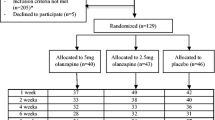Abstract.
Rationale: Previously, we have reported that the combination of ondansetron (a 5-HT3 antagonist) and naltrexone (a mu opioid antagonist) appears to act synergistically at improving the drinking outcomes of early onset alcoholics (EOA), a subtype of alcoholic characterized by developing problem-drinking earlier, antisocial behaviors, high familial loading, and biological disease predisposition. Presumably, this medication combination counteracts the interaction between activated central 5-HT3 receptors and the endogenous opioid system during the mediation of alcohol-induced reward. We now hypothesize further that an important mechanism by which the combination diminishes alcohol consumption is through a reduction in craving. Objective: To determine whether the combination of naltrexone and ondansetron is superior to a placebo at reducing craving among EOA, and the relationship between craving and drinking behavior in both treatment groups. Methods: We conducted an 8-week double-blind placebo-controlled clinical trial in which 10 EOA were randomized to receive ondansetron (4 µg/kg b.i.d.) + naltrexone (25 mg b.i.d.) and 10 EOA had a placebo (total n=20) as an adjunct to weekly standardized group cognitive behavioral therapy. Craving was measured by using the obsessive compulsive drinking scale (OCDS). Results: Craving ratings were scored on four subscales which where derived empirically by principal component structure analysis of the OCDS. EOA who received the medication combination, compared with the placebo, had significantly lower scores on "automaticity of drinking" and "alcohol consumption". Reduction in automaticity of drinking was correlated with self-reported drinking for only the medication combination group. Conclusions: By reducing automaticity of drinking, the medication combination presumably decreased drinking salience and intensity. Larger scale studies testing these medications, both alone and together, among alcoholic subtypes are needed to establish and extend these promising findings.
Similar content being viewed by others
Author information
Authors and Affiliations
Additional information
Electronic Publication
Rights and permissions
About this article
Cite this article
Ait-Daoud, N., Johnson, B., Prihoda, T. et al. Combining ondansetron and naltrexone reduces craving among biologically predisposed alcoholics: preliminary clinical evidence. Psychopharmacology 154, 23–27 (2001). https://doi.org/10.1007/s002130000607
Received:
Accepted:
Issue Date:
DOI: https://doi.org/10.1007/s002130000607




